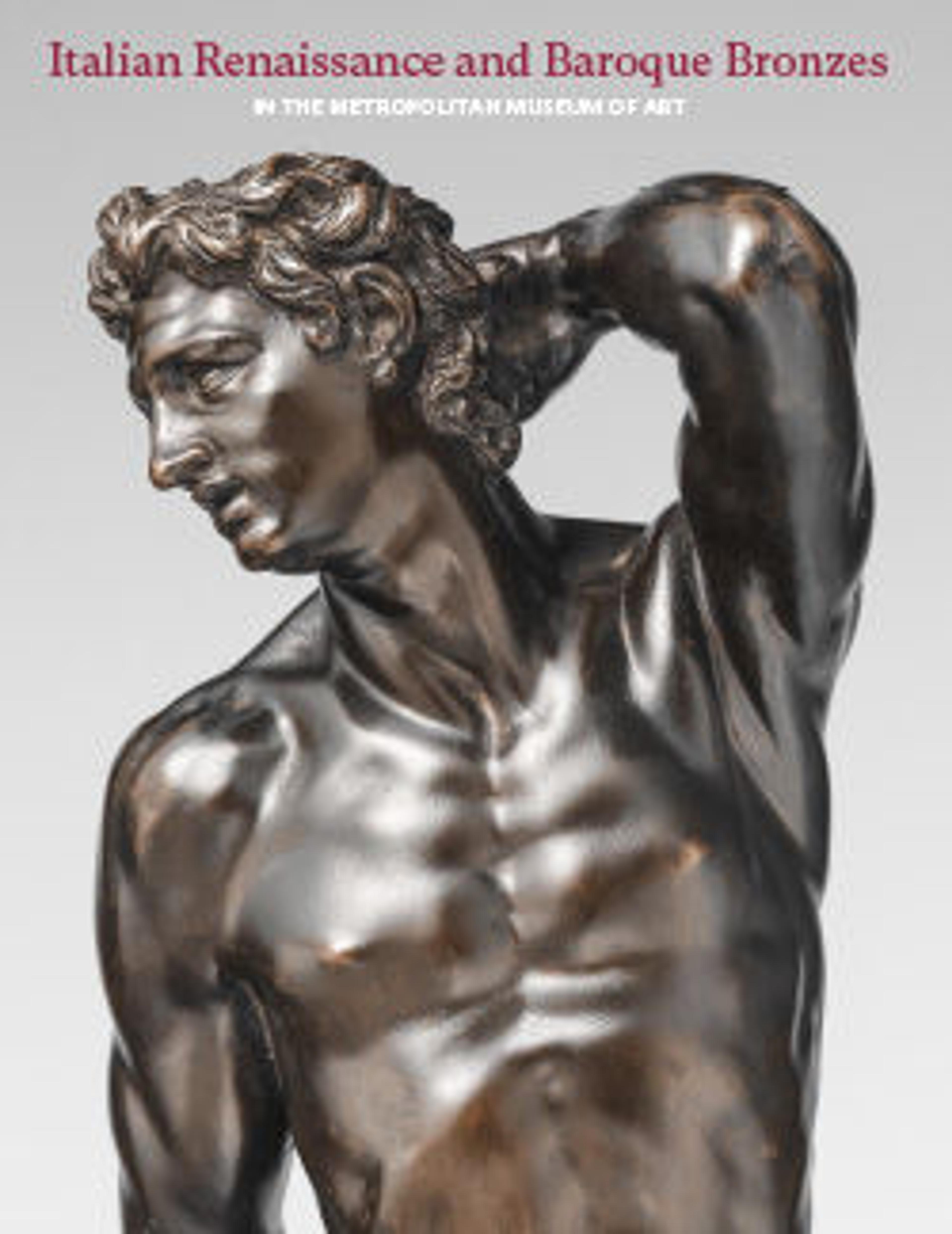Torch-bearing arm
This bronze sconce in the form of a human arm extends from a circlet of drapery, the hand gripping a vertical cylinder. The piece is hollow-cast with a light brown patina and traces of an overall transparent reddish brown lacquer and gilding. It came to The Met in 1977, when two elements not original to the composition were removed: a pan fitted to the cylinder for holding a candle, and an inverted bulblike ornament at the cylinder’s base. Wilhelm von Bode published the object as “Venice, about 1550.” While in Untermeyer’s possession, it was catalogued as Venetian and dated to the second half of the seventeenth century, but James David Draper thought it more likely a product of “an earlier moment under Florentine influence,” alluding to the manner of Giambologna and his followers. By 1985, it had acquired the more generic designation of Italian, late sixteenth or early seventeenth century.
The object’s rarity hinders analysis.[1] Sconces in the form of an arm appear in depictions of early modern interiors, for example, Vittore Carpaccio’s Saint Augustine in His Study (1502; Scuola di San Giorgio degli Schiavoni, Venice), though in this case it takes the form of a hairy animal limb with paw. Human arm sconces can be seen in a view of Fontainebleau Castle engraved by Abraham Bosse (fig. 143a). The question is whether our object was originally made to serve a lighting function as seen in these images. Its material condition provides some clues. Close visual examination reveals that different types of bronze were used in the fabrication of the drapery circlet and the arm. Their surface treatments differ as well, and two cracks are visible in the arm. In other words, the object’s current configuration does not seem to reflect its original state. It may be an accrochage of a previously cast arm and a wall fixture. The discarded pan and ornament were perhaps added when the arm was transformed into a sconce, a pastiche that might have been created in the nineteenth century. The taut, well-designed anatomy of the arm is consistent with Draper’s suggestion of a late Renaissance Florentine context. In fact, in its dramatic gesture, the arm recalls the forcefully outstretched limb of the Melchisedech molded in terracruda by Francesco Camilliani in 1569–70 for the Cappella di San Luca in Santissima Annunziata, Florence.[2]
-FL
Footnotes
(For key to shortened references see bibliography in Allen, Italian Renaissance and Baroque Bronzes in The Metropolitan Museum of Art. NY: The Metropolitan Museum of Art, 2022.)
1. R. Stone/TR, July 7, 2011, notes that the arm was cast using a very rare method, namely with straps presumably of iron bent together to form a sort of cage or basket, which was then filled with a refractory to form the core.
2. See Summers 1969, pp. 78–79.
The object’s rarity hinders analysis.[1] Sconces in the form of an arm appear in depictions of early modern interiors, for example, Vittore Carpaccio’s Saint Augustine in His Study (1502; Scuola di San Giorgio degli Schiavoni, Venice), though in this case it takes the form of a hairy animal limb with paw. Human arm sconces can be seen in a view of Fontainebleau Castle engraved by Abraham Bosse (fig. 143a). The question is whether our object was originally made to serve a lighting function as seen in these images. Its material condition provides some clues. Close visual examination reveals that different types of bronze were used in the fabrication of the drapery circlet and the arm. Their surface treatments differ as well, and two cracks are visible in the arm. In other words, the object’s current configuration does not seem to reflect its original state. It may be an accrochage of a previously cast arm and a wall fixture. The discarded pan and ornament were perhaps added when the arm was transformed into a sconce, a pastiche that might have been created in the nineteenth century. The taut, well-designed anatomy of the arm is consistent with Draper’s suggestion of a late Renaissance Florentine context. In fact, in its dramatic gesture, the arm recalls the forcefully outstretched limb of the Melchisedech molded in terracruda by Francesco Camilliani in 1569–70 for the Cappella di San Luca in Santissima Annunziata, Florence.[2]
-FL
Footnotes
(For key to shortened references see bibliography in Allen, Italian Renaissance and Baroque Bronzes in The Metropolitan Museum of Art. NY: The Metropolitan Museum of Art, 2022.)
1. R. Stone/TR, July 7, 2011, notes that the arm was cast using a very rare method, namely with straps presumably of iron bent together to form a sort of cage or basket, which was then filled with a refractory to form the core.
2. See Summers 1969, pp. 78–79.
Artwork Details
- Title:Torch-bearing arm
- Date:late 16th century?
- Culture:Possibly Italian
- Medium:Bronze, traces of gilding
- Dimensions:Length: 16 1/2 in. (41.9 cm)
- Classification:Sculpture-Bronze
- Credit Line:Gift of Irwin Untermyer, 1964
- Object Number:64.101.1487
- Curatorial Department: European Sculpture and Decorative Arts
More Artwork
Research Resources
The Met provides unparalleled resources for research and welcomes an international community of students and scholars. The Met's Open Access API is where creators and researchers can connect to the The Met collection. Open Access data and public domain images are available for unrestricted commercial and noncommercial use without permission or fee.
To request images under copyright and other restrictions, please use this Image Request form.
Feedback
We continue to research and examine historical and cultural context for objects in The Met collection. If you have comments or questions about this object record, please contact us using the form below. The Museum looks forward to receiving your comments.
